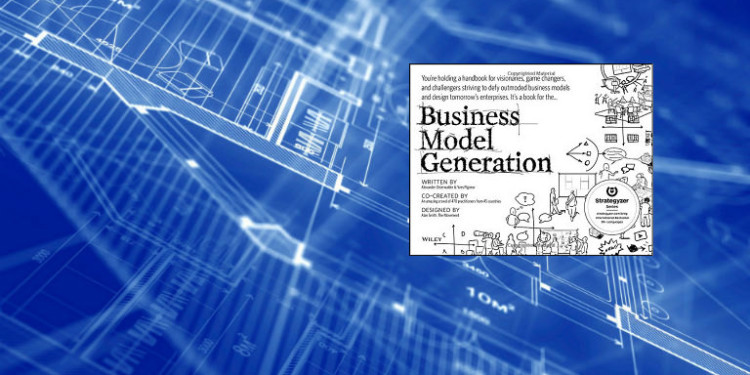(Re)Designing business models

Business Model Generation by Alexander Osterwalder
Business Model Generation (hashtag #bmgen on Twitter) is a unique book which is at the forefront of the current interest and emphasis on understanding business models and their design. Osterwalder and his co-creators define a business model in a malleable way that empowers the reader to extend, expand, and modify existing business models along a number of dimensions. Key to their method is a collaborative ideation work session that challenges participants to examine and overturn assumptions– he says that “business model innovation is about challenging orthodoxies” and “developing an appetite for new models”. Osterwalder’s Business Model Canvas, Steve Blank’s Customer Development and Eric Ries’ Lean Startup have been noted as three powerful tools for entrepreneurs and people transforming existing businesses.
This book is a complete package for reinventing your business model and spans theory, examples, templates, ideation methods, and a detailed process for strategic planning. Business Model Generation begins with the definition of the canvas and its elements. Using the canvas, Osterwalder describes five common business model patterns to illustrate each building block: unbundling, the long tail, multi-sided platforms, freemium, and open business models. To to help the business model design team, Osterwalder provides six key design methods for business model innovation: customer insights, ideation, visual thinking, prototyping, storytelling, and scenarios. With those tools in place, the book moves on to a broader strategic framework for business model reinvention–mapping the marketplace and larger economic environment, evaluating business models using SWOT analysis, and managing multiple business models. Osterwalder provides specific transformations and patterns for modifying existing business models. The environmental and evaluation sections of the book contain detailed lists of questions to ask as the team examines their business model. Finally, a step-by-step process is included that situates business model design within a larger business planning framework.
Business model innovation is typically motivated by the need to address current but unsatisfied market needs, to introduce a new product or service, to transform or disrupt an existing market, or to create a completely new market. These key strategic business imperatives can be well supported by the method in this book.
The Business Model Canvas
The Business Model Canvas is the central concept of the book and contains the elements of a business model: value proposition, cost structure, revenue streams, partners, activities, resources, customer relationships, channels and customer segments.
The Business Model Canvas is a bit like an artist’s canvas. When an artist starts painting, he often has a vague idea–not an exact image–in mind.
Crafting a business model is no different. Ideas placed on the Canvas will trigger new ones. The Canvas becomes a tool for facilitating the idea dialog…
Each element can be examined on its own or as it relates to others. By drawing each element by hand, the team working through the business model can find new opportunities and evaluate alternatives as a group. The Business Model Generation method is highly collaborative, visual, and iterative. The core of the process is the conversation and multiple viewpoints that are brought to bear around each element of the canvas and the relationships between elements. Prototyping is a key benefit of using the canvas, because key elements of a new business model can be discussed by the team and modified as each aspect is explored. The process embodies design thinking and involves all team members in innovation and future vision.
The right side of business model canvas emphasizes value, while the left side is predominantly cost driven. Financial considerations (costs, revenues) are on the bottom and value is at the center with connections to partners and customers.
The Business Model Environment
Osterwalder notes that “developing a good understanding of your organization’s environment helps you conceive stronger, more competitive business models.” To accomplish this environmental scan requires evaluating four external factors:
- Key Trends (regulatory, technology, social, economic)
- Industry Forces (supply chain, competitors, new entrants, substitutes)
- Market Forces (market segments, demand, issues, switching costs)
- Macro-Economic Forces (global markets, capital markets, infrastructure)
Examining each factor with a series of questions leads to new opportunities for each section in the business model. Alternatives for new customer segments, new resource needs, and revenue models may emerge. Likewise, different relationships with competitors and supply chain partners may come to light during the environmental scan.
Modifying your business model
Osterwalder applies the Four Actions Framework from Blue Ocean Strategy as provocative questions for business model reinvention:
- Which factors can you eliminate that your industry has long competed on?
- Which factors should be raised well above the industry’s standards?
- Which factors should be reduced well below the industry’s standards?
- Which factors should be created that the industry has never offered?
This set of questions can be applied against the cost, value, or customer sections of the business model canvas. Cost reduction, new investments, or replacement of one set of costs with another guide exploration of the cost side of the canvas. Focusing on the value segment has impacts to both costs and value segments as it surfaces new, reduced, or modified value elements. Applying the questions to the customer segments of the canvas yields new, reduced, or modified customer relationships and groups that then have effects on the value proposition and costs.
Another approach Osterwalder presents for business model innovation is the various epicenters which can drive change. The business model design team can begin questioning assumptions and generating ideas from each of these areas of the canvas.
- Resource-driven: starts with an organization’s current infrastructure or partnerships
- Offer-driven: new value propositions are created which drive change to the other canvas elements
- Customer-driven: customer insights or benefits affect other business model components
- Finance-driven: pricing or revenue model innovations affect other areas of the canvas
- Multiple-epicenter driven: change emerges from various business model building blocks
The Process
One of the revolutionary aspects of this book is the idea that business models should be evaluated, managed, and evolved along with other components of the business. This is a very progressive concept and enables fundamental business transformation and new value creation to take place. He applies a familiar five phase model to business model design process: mobilize (goals, objectives), understand (research, identify patterns), design, implement, and manage. He maps all the tools and case studies to each phase to provide a full toolkit for implementation. Osterwalder is, at the same time, quite objective about the level of process that can be applied to this domain given the complexity and scope of the undertaking.
The challenge, though, is that business model innovation remains messy and unpredictable, despite attempts to implement a process. It requires the ability to deal with ambiguity and uncertainty until a good solution emerges.The world is so full of ambiguity and uncertainty that the design attitude of exploring and prototyping multiple possibilities is most likely to lead to a powerful new business model.
In this video, Osterwalder presents the business model design approach to an audience at Google:







